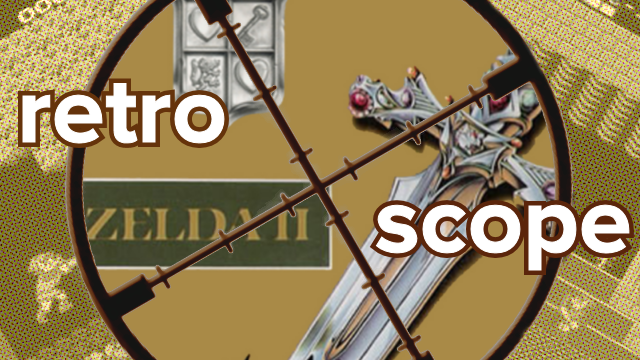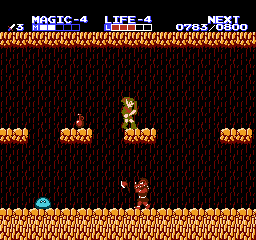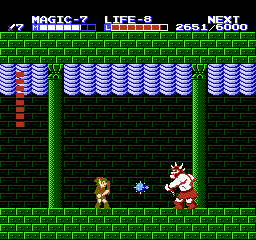
I’ve heard a lot of things said about Zelda II: The Adventure of Link. That it’s the black sheep of the Zelda series. That it’s the worst Zelda game. That it’s not even a real Zelda game. For being a numbered entry in one of gaming’s most beloved franchises, this NES classic gets a lot of flak from the series’ diehard fans. I admit to having done some of the insult slinging myself in the past, but I recently managed to get through all of Link’s second adventure and discovered that it is a much different game than I expected. Not only is Adventure of Link definitely a Zelda game, it also happens to be a very good one, and offers an interesting look into what could have been for this legendary franchise.
The differences between Zelda II and its predecessor are instantly noticeable. The game opens with Link standing in front of an altar where a sleeping Zelda lies. But instead of a top-down view, we are seeing a much larger, more detailed sprite of Link from the side, somewhat similar to the dungeon item rooms from the first Zelda. But unlike the dark basements from the that game, the sidescrolling sections in Zelda II aren’t tucked away; they make up almost the entire game. The top-down camera view still plays a part in the overworld, but in the dungeons the game focuses purely on your platforming and combat skills rather than puzzles.
As you would expect, this new format lead to a complete gameplay overhaul, and Zelda II is much more of an action RPG than its predecessor. Rather than finding heart pieces and weapons, you gain experience and level up your attributes: Health, Magic, and Attack. Rather than collecting items to progress, you complete side quests to learn magic spells that help you reach new areas, as well as aid you in combat. Most of the items you do find in dungeons have very specific one-time uses like the raft. The game still leads you toward your goals with arcane tips from townspeople and signs, and there is plenty of exploration and trial-and-error required to make your way across Hyrule.


A big part of the trial-and-error are the battles, which are encountered on the overworld map as well as in dungeons. Battles are the true test of your mettle in Zelda II, and their brutal difficulty is probably what turns off most would-be fans. It is a major step up from The Legend of Zelda’s simple combat system; Link’s moveset has expanded from one simple swing of the sword to a variety of techniques that include ducking, jumping, blocking, and of course stabbing. The combat seems simple at first, but like the best action games, Zelda II keeps things interesting with a variety of challenging enemies and scenarios. You can wildly jab your way through the early game, but once enemies start blocking your attacks and throwing projectiles, things change quickly.
Most players reach this point and immediately call foul on what they feel is an unfairly difficult game, but really Zelda II is just testing you. The game is asking you to master skills like blocking and dodging early on because you will need a combination of all Link’s skills to succeed in the late game. For example, the first time you face a dagger-throwing Iron Knuckle the fight may feel insurmountable. His projectiles fly randomly through the air, knocking you back whenever you dare get too close. No doubt you will be frustrated, but realize that the game is trying to teach you. Watch his hands, notice that you can see where he will throw the dagger a second before he looses it. Using this information, you can block every dagger as you approach. When you get close enough you need to block and stab in rhythm, avoiding damage and dealing it at the same time. By the time you have defeated him, you will be a master of blocking. Zelda II is full of moments like these, and you can always feel yourself getting better at what might be the Zelda series’ best combat system.
Maybe at this point you are rolling your eyes at these claims. Maybe you have already tried Zelda II time and time again and are steadfast in your opinion that it just isn’t for you. I know these feelings because I held them for many years. If you are a Zelda fan who feels this way, I encourage you to heed my words. Zelda II is a great game. Give it a another shot. Give it a real shot. Do whatever you need to do. Play on Virtual Console, use a guide, take advantage of save states. It’s well worth it to see what this unique game has in store for you. Make it farther than you ever have before. Beat bosses you thought you never could. Maybe you will make it to the game’s final dungeon and defeat the game’s ultimate challenge. It will take time, commitment, and a whole lot of deaths, but once you see Link lift that Triforce above his head, it will all be worth it. Trust me.




 ShareThis
ShareThis







Well said! It took me a long time to give Zelda 2 its fair shake (I finally completed it on the GameCube via that wonderful Collector’s Edition disc). But everything written here is spot-on.
Those “unfair” moblins and tall desert claws teach you the basics of combat. The “unfair” darknuts teach you shield technique. The “unfair” axe-wielding aligators teach how to manage distance in battle. The various “cheap” floating/hopping/crawling enemies teach the use of vertical attacks. On and on it goes.
By the end of the game, not only is Link a decked-out badass, but so is the player! Link has his items, attacks and magic, and the player is armed with some serious gaming chops.
Thanks! I agree with what you said about the player being armed alongside Link. In a lot of ways Zelda II feels like a retro version of Dark Souls to me. Challenging, but always fair.
I’ve never understood all the hate for this game. This is my favorite game from the original NES period. Of course I played it when it first released and the Zelda formula hadn’t solidified so I see why people thing it is the dark horse of the franchise. Looking back with 20/20 hindsight it doesn’t feel like a Zelda game.
Taken as it’s own entity, without the benefit of revisionist history, this is a great action rpg with many great elements. I can’t think of another rpg from that time that was also so fast paced. That and smb 3 are the only two games I revisit regularly from that era.
One of the complaints I often hear, and is referenced in this article, is that it is too hard. There is no denying it is challenging, but it isn’t that difficult. I’m not exactly objective here since my favorite games are ones like demon/dark souls, FTL, and binding of Isaac, all notoriously difficult games. However, my wife, who is not a gamer, and is maddeningly bad at most games, beats this game about once a year. If she can do it no one has an excuse.
I finally finished this for the first time three days ago, and in terms of game design, the game is much better than its reputation. In terms of difficulty, however, I believe it does move into the realm of unfair. I compare it to the first two Mega Man games. Both have the same game design, which is solid, but while the second is challenging, the first is so hard as to be unfair. Had Zelda II just toned it down a bit, everything else, from the side-scrolling combat to overworld exploration, would have made for a fantastic game. As it is, it stands as a reminder of how things used to be: sequels that diverged from their predecessors (think Simon’s Quest), and gameplay that comes from the mindset of eating quarters.
I too never understood the hate this game received.
Having just a tad of health left, down on the bottom floor of one of the later castles was enough to give you a real sense of dread. The atmosphere and style of the Zelda universe, as it was presented here, was much darker in its tone and feeling than anything felt in the series for quite a while (I would say up until Majora’s Mask – if you take out the obnoxious kiddy elements thrown into that one). The music was absolutely wonderful – again layering the mood thick and heavy throughout.
The difficulty was always in the perfect spot. Where the overall journey presented a great challenge – you had to be on your game – but Game Overs were still rare, and more importantly, deserved. The Iron Knuckle battles, an exercise in guessing whether his shield was high or low while simultaneously blocking his attacks (high or low) were the perfect lynch-pins for frantic gaming moments, deep dungeon fear, and hectic, challenging, and fair game-play.
I always considered Zelda II a real gem. But it’s understandable, when placed alongside a game that birthed an entire genre, the lustre may be a bit unfairly tarnished.